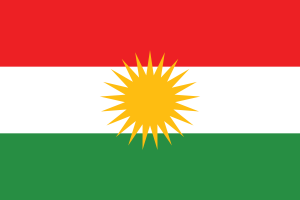Language/Central-kurdish/Grammar/Forming-Simple-Sentences
| ◀️ Ordinal Numbers — Previous Lesson | Next Lesson — Questions and Negations ▶️ |
Introduction[edit | edit source]
Welcome to the lesson on forming simple sentences in Central Kurdish! In this lesson, we will explore the basic sentence structure of Central Kurdish and learn how to create meaningful sentences using the subject-verb-object (SVO) format. Understanding sentence structure is crucial for effective communication in any language, and Central Kurdish is no exception. By the end of this lesson, you will have a solid foundation in Central Kurdish grammar and be able to construct simple sentences with ease. So let's get started!
Sentence Structure in Central Kurdish[edit | edit source]
Central Kurdish follows a subject-verb-object (SVO) sentence structure, which means that the subject comes before the verb, and the object comes after the verb. This structure is similar to English and many other Indo-European languages. Let's break down the components of a simple sentence in Central Kurdish:
- Subject: The subject is the person or thing that performs the action in the sentence. It can be a noun, a pronoun, or even a phrase. For example: "Zana" (Zana), meaning "Zana".
- Verb: The verb is the action or state of being in the sentence. It describes what the subject is doing or experiencing. Central Kurdish verbs are conjugated based on tense, aspect, and mood. For example: "xwendin" (xwendin), meaning "to read".
- Object: The object is the person or thing that receives the action of the verb. It can be a noun, a pronoun, or even a phrase. For example: "kutab" (kutab), meaning "books".
Now that we understand the basic components of a simple sentence in Central Kurdish, let's see some examples to further illustrate the concept.
Examples[edit | edit source]
Example 1[edit | edit source]
Central Kurdish: "Zana xwendin kutab."
Pronunciation: [zaːna xwɛnˈdin kuˈtab]
English Translation: "Zana reads books."
In this example, "Zana" is the subject, "xwendin" is the verb, and "kutab" is the object. The sentence follows the SVO structure, where the subject comes first, followed by the verb and the object.
Example 2[edit | edit source]
Central Kurdish: "Min pîroz dikim te."
Pronunciation: [min piːˈroz diˈkim tɛ]
English Translation: "I congratulate you."
In this example, "Min" is the subject, "pîroz dikim" is the verb, and "te" is the object. The verb "pîroz dikim" is a compound verb meaning "to congratulate." Again, the sentence follows the SVO structure.
Example 3[edit | edit source]
Central Kurdish: "Evin bajarî Kurdistan e."
Pronunciation: [ˈɛvin baˈd͡ʒaːˈri kurdɪsˈtaːn ɛ]
English Translation: "This is a Kurdish city."
In this example, "Evin" is the subject, "bajarî" is the verb, and "Kurdistan" is the object. The sentence follows the SVO structure.
Example 4[edit | edit source]
Central Kurdish: "Dengê min li serî te ye."
Pronunciation: [dɛnˈgɛ min li sɛˈri tɛ je]
English Translation: "My voice is on your side."
In this example, "Dengê min" is the subject, "li serî" is the verb, and "te" is the object. The phrase "li serî" is a prepositional phrase meaning "on." Again, the sentence follows the SVO structure.
Cultural Insights[edit | edit source]
Central Kurdish is spoken primarily in the Kurdistan region, which is located mainly in Iraq, but also extends into parts of Iran, Syria, and Turkey. The Kurds are an ethnic group with a rich cultural heritage, and their language reflects their unique history and traditions.
In Central Kurdish-speaking regions, the SVO sentence structure is the most common and widely used. However, it's worth noting that there are some regional variations in sentence structure within the Kurdish language as a whole. For example, in some dialects, such as Kurmanji Kurdish, the sentence structure may follow a subject-object-verb (SOV) pattern. These regional variations are influenced by historical and geographical factors, as well as contact with neighboring languages.
An interesting cultural fact about Central Kurdish is that it is written using a modified version of the Latin script. This change was implemented in the 1930s as part of a broader language reform movement in the region. Prior to that, Central Kurdish was primarily written using the Arabic script. The adoption of the Latin script has helped to standardize the writing system and make it more accessible to Kurdish speakers across different regions.
Practice Exercises[edit | edit source]
Now that we have learned about the basic sentence structure in Central Kurdish, let's put our knowledge into practice with some exercises. Try to form sentences using the given prompts, and then check your answers below.
Exercise 1: Form a sentence using the following prompts: "Kamal" (Kamal), "serçavka" (serchavka), "bavê" (bave).
Answer: "Kamal serçavka bavê." (Kamal is the father's bird.)
Exercise 2: Form a sentence using the following prompts: "Ez" (Ez), "çay" (chay), "xwendim" (xwendim).
Answer: "Ez çay xwendim." (I drank tea.)
Exercise 3: Form a sentence using the following prompts: "Tu" (tu), "gotî" (goti), "destpêkê" (destpeke).
Answer: "Tu gotî destpêkê." (You said the beginning.)
Exercise 4: Form a sentence using the following prompts: "Navê" (Nave), "hêlîn" (helîn), "kurmancî" (kurmanci).
Answer: "Navê hêlîn kurmancî." (The name is Helin in Kurdish.)
Solutions[edit | edit source]
Exercise 1: "Kamal serçavka bavê." Exercise 2: "Ez çay xwendim." Exercise 3: "Tu gotî destpêkê." Exercise 4: "Navê hêlîn kurmancî."
Conclusion[edit | edit source]
Congratulations! You have successfully learned how to form simple sentences in Central Kurdish using the subject-verb-object (SVO) structure. Understanding sentence structure is essential for effective communication in any language, and Central Kurdish is no exception. By practicing with the provided exercises, you can further reinforce your knowledge and improve your skills in constructing meaningful sentences. Keep up the great work, and continue your journey to mastering the Central Kurdish language!
Other Lessons[edit | edit source]
- Common Prepositions
- Gender
- Questions
- Nouns
- Possessive Pronouns
- Pronouns
- Subject Pronouns
- Present Tense
- Give your Opinion
Template:Central-kurdish-Page-Bottom
| ◀️ Ordinal Numbers — Previous Lesson | Next Lesson — Questions and Negations ▶️ |

